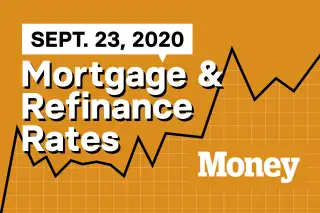Here Are Today's Best Mortgage & Refinance Rates for September 23, 2020

Borrowers with 700 credit scores were quoted an average rate of 3.679% to secure a 30-year fixed-rate purchase mortgage on Tuesday, according to Money's daily survey of over 8,000 lenders across the United States. At this credit score, roughly the national average, the rate for a 30-year refinance was 4.525%. Our rates include discount points and are for borrowers putting 20% down.
| 30-year fixed-rate purchase mortgage |
| 3.679% |
| Rate of September 22, 2020 |
Borrowers in Ohio were quoted the lowest mortgage rates on Tuesday—at 3.46%. Those in Rhode Island saw the highest average rate at 3.815%. Nationwide, borrowers with the highest credit scores, 740 and above, were quoted rates averaging 3.154%, while those with credit of 640 or below were given rates of 4.796%—a 1.642 percentage point spread.
You may be able to negotiate a lower rate if you shop around or if you have other accounts with the lender. (Money's picks for the best mortgage lenders are here.) Currently, some banks are hiking up advertised rates to keep demand in check, so you may be offered a lower rate if you reach out directly.
Freddie Mac's widely quoted Primary Mortgage Market Survey put rates at 2.87% with 0.8 points paid for the week ending September 17. The mortgage purchaser's weekly survey reflects borrowers who put 20% down on conforming loans and have excellent credit.
Refinance rates today
Money's survey also shows that the offered rate for a 30 year refinance for someone with a 740 credit score was 3.838% on Tuesday. Last September, the average mortgage rate (including fees) was 3.922%.
| 30-year fixed-rate mortgage refi |
| 3.838% |
| Rate of September 22, 2020 |
A homeowner with a $200,000 mortgage balance currently paying 3.922% on a 30-year loan could potentially cut their monthly payment from $946 to $936 by financing at today's lower rates. To determine if it's worth it to refinance your mortgage, also consider the closing fees you paid on your current mortgage, how much your new lender is charging and how long you have left on your loan term. (Our picks for the best lenders for refinancing are here).
What else is happening in the housing market right now?
Existing home sales reached an annually adjusted rate of 6 million units in August. The 2.4% increase from July marked three straight months of gains, according to the National Association of Realtors. Year-over-year, sales were up 10.5% and hit their highest level since December 2006.
Monthly gains were achieved across regions, with the largest increase occurring in the Northeast which jumped 13.8% from July and 5.7% from 2019. In the Midwest, home sales were up 1.7% month-over-month and 9.3% year-over-year. The South and the West saw monthly increases of 0.8% and annual gains of 13% and 9.6% respectively.
"Home sales continue to amaze, and there are plenty of buyers in the pipeline ready to enter the market," said Lawrence Yun, NAR’s chief economist. "Further gains in sales are likely for the remainder of the year, with mortgage rates hovering around 3% and with continued job recovery."
High buyer demand and a low housing inventory pushed the median existing-home price in August up to $310,600, an increase of 11.4% from last year ($278,800), with prices rising across all regions. Supply, meanwhile, is down 18.6% from August of last year. The total housing inventory at the end of August sat at 1.49 million units, representing about a three months supply at the current pace of sales. (Six months is considered healthy.)
While homebuyer demand remains strong, concerns about the lack of new homes have increased recently as the wildfires in California have put a dent in lumber supplies and rising prices have made building material both scarcer and more expensive.
"Over recent months, we have seen lumber prices surge dramatically. This has already led to an increase in the cost of multifamily housing and an even higher increase for single-family homes," said Yun.
"Housing demand is robust but supply is not, and this imbalance will inevitably harm affordability and hinder ownership opportunities. To assure broad gains in homeownership, more new homes need to be constructed," he added.
Meanwhile, interest in purchasing and refinancing mortgages remains strong midway through September. The total number of mortgage loan applications increased 6.8% during the week ending September 18, according to the Mortgage Bankers Association. Purchase loan applications increased a seasonally adjusted 3% and were 25% higher than the same week last year. Refinance applications saw a 9% week-over-week increase and a whopping 86% increase from the same time last year.
Quote of the Week
There’s always something to do in a house,” said Aaron Share of Jameson Sotheby's International Realty in Chicago. “It never ends. There’s always going to be another project or another something that needs to be fixed or updated at some point because nothing lasts forever.”
From: The Ultimate Guide to Ditching the City and Moving to the Suburbs
Bottom line:
Mortgage Rates Vary From State to State. Here's How to Get the Best Deal if You're Moving
The Ultimate Guide to Ditching the City and Moving to the Suburbs
Procrastinators, It's Not Too Late to Refinance Your Mortgage and Save Thousands